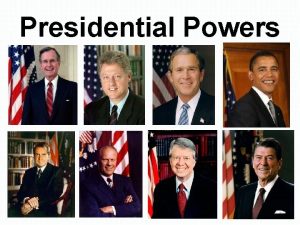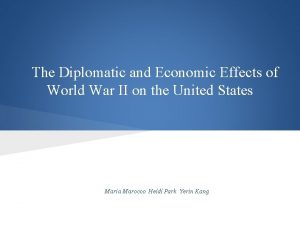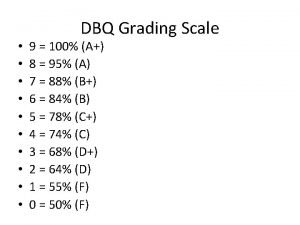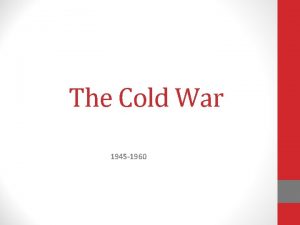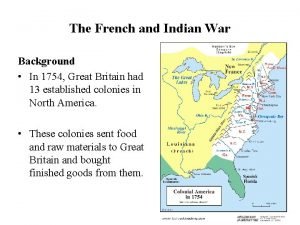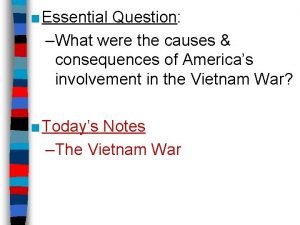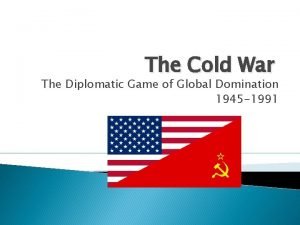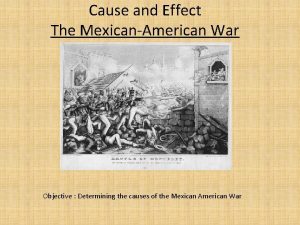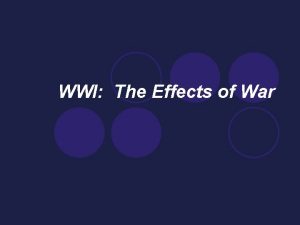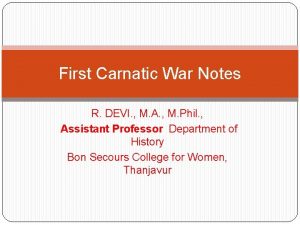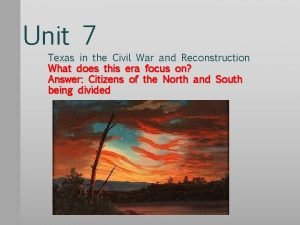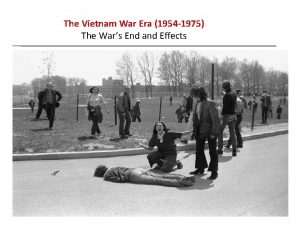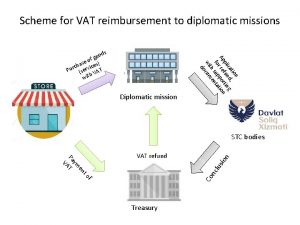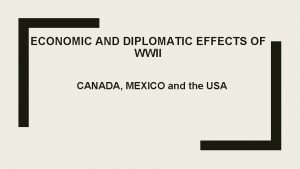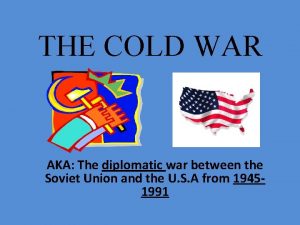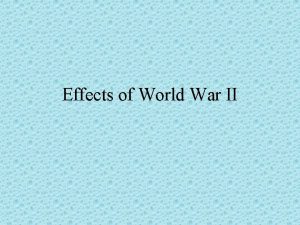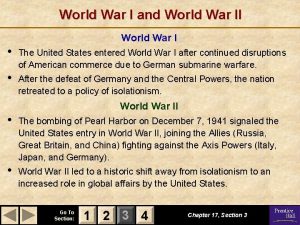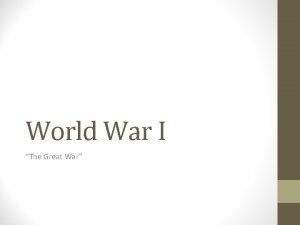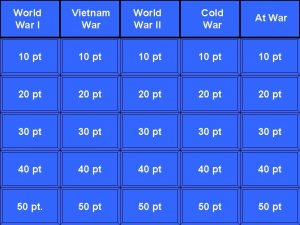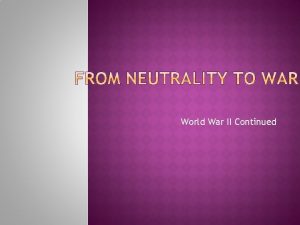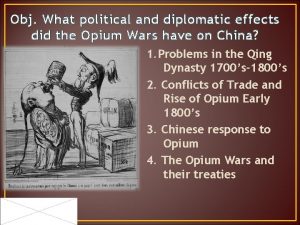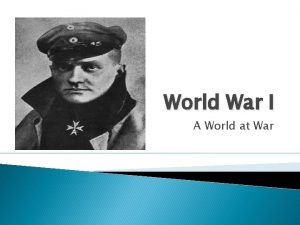Economic and Diplomatic Effects of the World War





































- Slides: 37

Economic and Diplomatic Effects of the World War II on Canada By: Lora Kim Meha Marathe Connie Weng

Background Information

Entering the War September 10, 1939: declared war on Germany Entered the war with a struggling economy Great Depression of the 1930 s Later declared war on Italy (June 11, 1940) Japan (December 7, 1941) Other Axis Powers

Mobilization By 1942, Canada adopted a policy of Total War Mobilization of support through propaganda campaigns

Conscription Prime Minister Mackenzie King in 1939 promise that there would be no conscription Pressure for volunteers prompted King to hold a vote for/against conscription - “yes” side won with 64% Ø 73% of Quebec said “no” November, 22 1944 – King forced to order conscription - very few recruits from this consumption actually went to fight in the war

Women and the War Faced labor shortages as early as 1941 Began recruiting women First single women only but later all women About 261, 100 worked in munitions factories Not allowed to fight in combat BUT allowed to enlist in divisions of the Army, Navy, and Air Force Nurses, machine operators, cooks, flying planes, etc. During the war, women in the military were paid only 60% of what men were paid

Economic Effects

Goodbye Depression! Government took full control of the economy Created employment WWII launched Canada out of the depression Experienced an economic boom Became an industrial power New factories built and old ones restored for war purposes Produced thousands of ships, guns, fighter planes, military vehicles Big investments in mining, production, transportation, and service industries Many were better off, economically, in 1945 than in 1930, but sustained themselves with deferred hopes and did not consume immediately

Paying for the War Rose income taxes during the war Victory Bond drives Encouraged workers to put money in Victory loans and savings plans By end of war raised nearly $12 billion 9 drives between June 1941 and October 1945

Rationing Despite the economic boost from the war… Shortage of food and other products to supply military Rationed items such as: Meat, butter, tea, coffee, gasoline, tires, etc.

Rationing after the war Elimination of rationing on gasoline Canadians can take the roads (can freely drive) No more wartime savings plan and other restrictions (barely rationed any materials) Because there was an economic boom, there was a lot of money available, making Canadians wanting to consume more Cars - 1946: sold 78, 000 *This is because there was an increase - 1947: sold 159, 000 in money and many wanted to consume

Employment After the War Government wanted to assert “full employment” In April 1945, the Liberal Government issued the White Paper Policy for full employment. It served its immediate purpose of getting the Liberal government re-elected - white paper policy was effective Employment didn’t fall after the war (consistency) People had money - marriage, families, education

Diplomatic Effects

Canada and Britain Lent money to British interest-free Gave Britain gift of war supplies in 1942 Royal Canadian Navy at Britain’s disposal 38% of the total Canadian production went to the British Remainder of the vehicles went to other Allies After the war, Canada grew further away from Britain, no longer British, Scottish, or American, they were Canadian.

Canada and the United States Canada and U. S. relations strengthened Canadian industries manufactured war materials and other supplies for the United States, Britain, and other Allies such as military transport vehicles, tanks, aircraft, ammunition and hospital supplies

Canada’s Munitions • Mass production of 815, 729 military vehicles, including 45, 710 armored vehicles. Canadian-made vehicles were crucial in equipping the British Eighth Army in North Africa and Italy.

Canada and the Axis Powers The War Measures Act of 1914, gave the federal government full authority to do everything deemed necessary “for the security, defense, peace, order and welfare of Canada”. 26 internment camps were set up across Canada In 1940 an Order in Council was passed that defined enemy aliens as “all persons of German or Italian racial origin who have become naturalized British subjects.

Canada Internment Camps • After the bombing of Pearl Harbor , a 100 -mile radius of the BC coast 22, 000 Japanese Canadians were given 24 hours to pack before being interned. • Women, children and older people were sent to internment camps • Men were forced into road construction camps • forced the Japanese Canadians to go to Japan and lose their Canadian citizenship, or move to eastern Canada

Canada and Germany Great Britain, faced with a possible invasion by Hitler, asked Canada to accept 4, 000 civilian internees and 3, 000 German prisoners of war. By October 1944, nearly 34, 000 military prisoners were held in Canada

Canada and the Soviet Union Evidently, there was a growing communist party in Canada Canadian Communist Party had come a long way since its founding in 1921 Earned support from Stalin; had to obey him Some of Stalin’s information about atomic power came from Canada - officials in the Soviet embassy in Ottawa sent 2 spies to find out about atomic secrets; their covers were blown Their relationship during the end of World War II contributed to the Cold War, a 45 -year confrontation between Western Powers and the Soviet Union

Are You Smarter Than a 5 th Grader?

5, 000 51, 000 31, 000 Are You Smarter Than a 5 th Grader? 5 th Grade Topic 1 4 th. Grade Topic 2 1, 000 3 rd Grade Topic 3 1, 000 2 nd Grade Topic 4 1, 000 1 st Grade Topic 5

5 th Grade Topic 1 Question v. What Policy did Canada adopt by 1942?

5 th Grade Topic 1 Answer A Total War Policy

5, 000 51, 000 31, 000 Are You Smarter Than a 5 th Grader? 5 th Grade Topic 1 4 th. Grade Topic 2 1, 000 3 rd Grade Topic 3 1, 000 2 nd Grade Topic 4 1, 000 1 st Grade Topic 5

4 th Grade Topic 2 Question v How was the economy able to pay for the war?

4 th Grade Topic 2 Answer Victory Bonds

5, 000 51, 000 31, 000 Are You Smarter Than a 5 th Grader? 5 th Grade Topic 1 4 th. Grade Topic 2 1, 000 3 rd Grade Topic 3 1, 000 2 nd Grade Topic 4 1, 000 1 st Grade Topic 5

3 th Grade Topic 3 Question v. In 1915, Liberal Government issued the _____ paper policy for free employment?

3 th Grade Topic 3 Answer White

5, 000 51, 000 31, 000 Are You Smarter Than a 5 th Grader? 5 th Grade Topic 1 4 th. Grade Topic 2 1, 000 3 rd Grade Topic 3 1, 000 2 nd Grade Topic 4 1, 000 1 st Grade Topic 5

2 th Grade Topic 4 Question Who were forced into internment camps?

2 th Grade Topic 4 Answer Japanese and Germans

5, 000 51, 000 31, 000 Are You Smarter Than a 5 th Grader? 5 th Grade Topic 1 4 th. Grade Topic 2 1, 000 3 rd Grade Topic 3 1, 000 2 nd Grade Topic 4 1, 000 1 st Grade Topic 5

1 st Grade Topic 5 Question Who was the Prime Minister of Canada in 1939?

1 st Grade Topic 5 Answer Mackenzie King

Works Cited Bothwell, Robert. The Penguin History of Canada. Toronto: Penguin Canada, 2007. Print. Epp, Marlene. "Joan Sangster, Transforming Labour: Women and Work in Post-War Canada. " Manitoba History 69 (2012): 46+. Questia School. Web. 7 Nov. 2012. Freedman, Charles. "Inflation Targeting and the Economy: Lessons from Canada's First Decade. " Contemporary Economic Policy 19. 1 (2001): 2. Questia School. Web. 7 Nov. 2012. Hawes, Michael K. "Introduction: Managing Canada-U. S. Relations in Difficult Times. " American Review of Canadian Studies 34. 4 (2004): 593+. Questia School. Web. 7 Nov. 2012.
 Diplomatic effects of ww2 on canada
Diplomatic effects of ww2 on canada Chapter 14 section 3 diplomatic and military powers
Chapter 14 section 3 diplomatic and military powers Code of diplomatic etiquette and precedence
Code of diplomatic etiquette and precedence Code of diplomatic etiquette and precedence
Code of diplomatic etiquette and precedence Code of diplomatic etiquette and precedence
Code of diplomatic etiquette and precedence World war 2 effects
World war 2 effects Ww2 causes
Ww2 causes Atiquette
Atiquette Function of diplomatic mission
Function of diplomatic mission Diplomatic revolution ap euro
Diplomatic revolution ap euro Causes and effects of the french and indian war
Causes and effects of the french and indian war Dbq grading scale
Dbq grading scale Growth and development conclusion
Growth and development conclusion Summary on the cold war
Summary on the cold war Persian wars cause
Persian wars cause French and indian war causes
French and indian war causes What were the causes and effects of the vietnam war
What were the causes and effects of the vietnam war Positive effects of primate cities
Positive effects of primate cities Chapter 16 lesson 2 challenges to slavery
Chapter 16 lesson 2 challenges to slavery Economic growth vs economic development
Economic growth vs economic development Economic systems lesson 2 our economic choices
Economic systems lesson 2 our economic choices Effects of the cold war
Effects of the cold war Effects of the mexican-american war
Effects of the mexican-american war Cause and effect of mexican american war
Cause and effect of mexican american war Negative effects of war
Negative effects of war Carnatic war notes
Carnatic war notes Effects of ww1
Effects of ww1 Effects of the civil war
Effects of the civil war Effects of the vietnam war
Effects of the vietnam war Effects of cold war
Effects of cold war Economic causes of war of independence 1857
Economic causes of war of independence 1857 War at home and abroad madison
War at home and abroad madison Description
Description Lesson 1 the origins of the cold war
Lesson 1 the origins of the cold war Presidential and congressional reconstruction venn diagram
Presidential and congressional reconstruction venn diagram Josette dugas
Josette dugas Ich war du warst
Ich war du warst Studyjams force and motion
Studyjams force and motion

